Informal Architectures
Chocolate has become a sign for wretched excess and the smell of it, emanating from William Pope. L’s sinister Historic Building, was heavy on the air in “Informal Architectures” when it opened at the Walter Phillips Gallery of The Banff Centre. Curated by Anthony Kiendl, the exhibition is part of a four-year project that examines how we live now through aspects of the built environment and other structures—social, political, institutional and cultural—that shape, express and mirror the conditions of contemporary life in a post-9/11 capitalist consumer society.
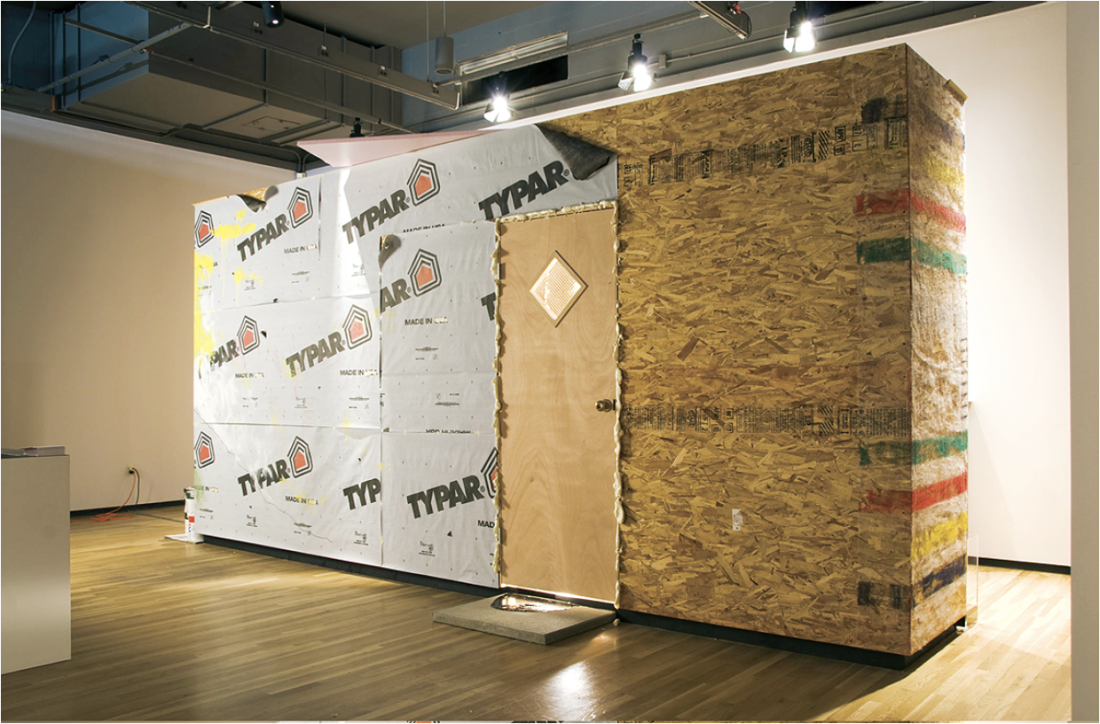
William Pope.L, Historic Building, 2007, mixed media, 131 x 549 x 244 cm. Photo: Tara Nicholson. Courtesy the artist, The Project, Kenny Schachter ROVE and The Banff Centre.
Pope.L’s trailer-size installation was positioned to almost block the wide entrance to the Phillips Gallery. Its back wall was in front of the viewer, and there was no overlooking the fact that the four aligned holes drilled into the wall were oozing something brown. This “something brown” ran down the wall in separate streams that collected at the bottom in a plastic trough. The substance is chocolate, but it’s hard not to think of it as scatological, and maybe that is part of the point of Pope.L’s visceral, vehement shack.
A dark substance seeps out from under the dimly lit front door. Tarpaper covers the facade. A Hudson’s Bay blanket is pasted over one end, and a collection of paint cans is stacked up at the other. The shack speaks of the outskirts of town or vacant lots, of the semi-rural or the semi-urban, some in-between place where people with no money have to make do. Historic Building suggests that someone has improvised a home from scavenged materials.
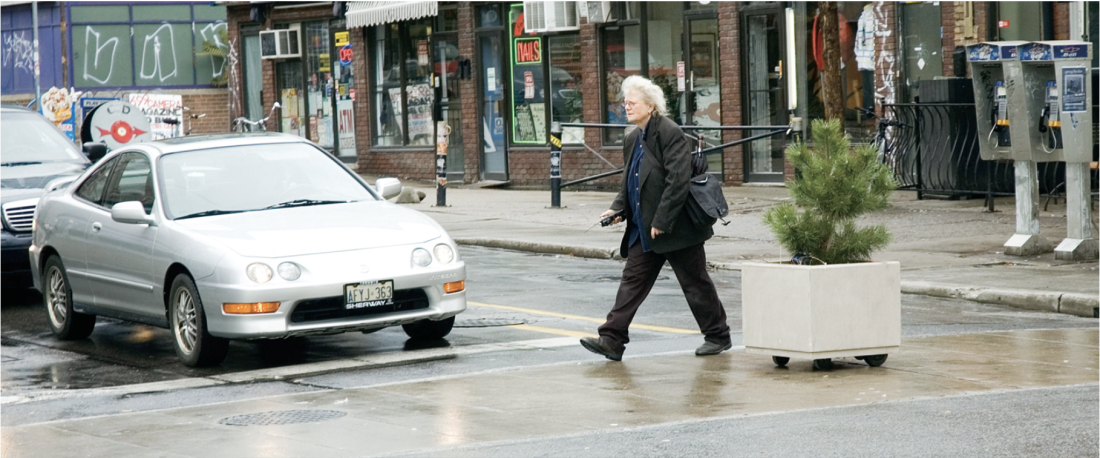
Rita McKeough, Long Haul, 2006, performance and installation. Photo: Johanna Householder and Dave Kemp. Courtesy The Banff Centre.
At the same time malevolent and banal, it is “historic” because it reveals a particular condition at a particular time: a capitalist consumer society of haves and have-nots whose most important product, no matter how sweet it smells, is getting to be waste. “I wanted people to relate to the show viscerally,” says Kiendl, who is director of Plug In ICA in Winnipeg and former director of the Walter Phillips Gallery. He uses “architecture” in the broad sense of “structure,” he says, be it “social, institutional, political or the built environment.”
Kiendl’s starting point was Georges Bataille’s concept of the formless and “the way Bataille talked about the formless as performing an operation by which the order of things was leveled and you could look at things from a fresh perspective outside of Modernism. More broadly speaking, my interest is Modernism and artists’ responses to it over the past 50 years, and a way of coming to terms or reimagining or trying to find a subjective space within Modernism.”
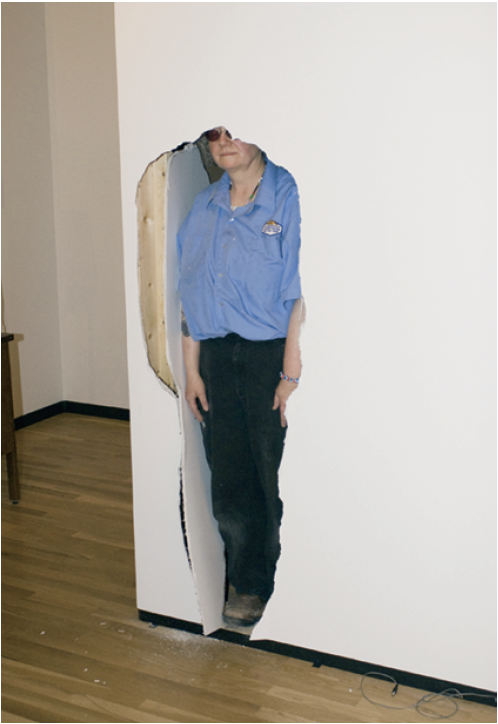
Rita McKeough, Long Haul, 2007, performance and installation. Photo: Tara Nicholson. Courtesy The Banff Centre.
Abjection, waste, rampant materialism, entropy, poverty, homelessness, anxiety, ambiguous fears and life in the shadow of 9/11 are all brought to the foreground by “Informal Architectures.” Taking a page from Walker Evans’s book, Calgary artist Ryan Nordlund photographs suburban tract houses to look like skulls. American artist Dan Graham videotaped West Edmonton Mall on two trips, 20 years apart, to produce Death by Chocolate, 1986–2005. Afghani artist Lida Abdul imagines a boy amid the ruins of war in Dome, 2005. In the eight-minute film, Fresh Kill, 1972, one of the exhibition’s strongest, most concise works, American Gordon Matta-Clark follows his red truck as it’s torn to bits of red metal by a bulldozer at the Fresh Kill Landfill, later the resting place of the destroyed World Trade Center towers. A rapacious bulldozer appears again in Calgary artist Rita McKeough’s Knockout, 1982, a lithograph in which a bulldozer topples a one-family house. Their gladiatorial combat, an image inspired by Calgary’s last boom cycle, takes place deep in a building excavation. But the little house, flat on its back, still has its dukes up.
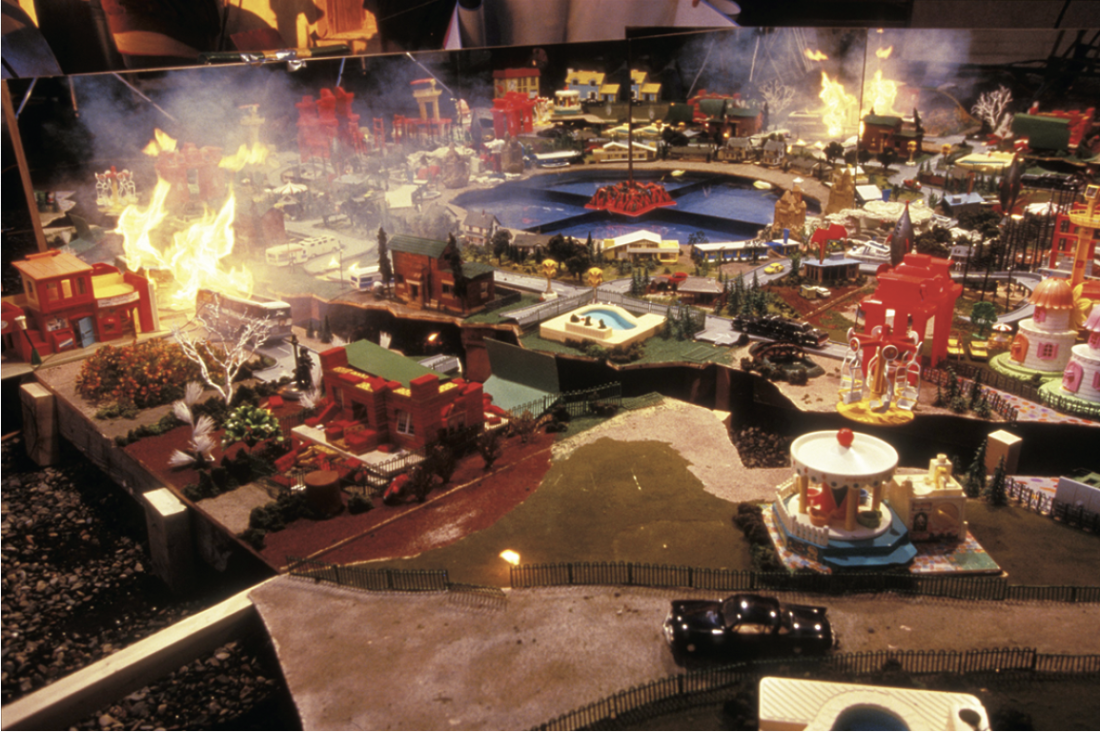
David Hoffos, Catastrophe, 1998, six-channel video and audio installation with mixed media, dimensions variable. Photo: David Hoffos. Courtesy the artist, TrépanierBaer Gallery and The Banff Centre.
The 22 works in “Informal Architectures” had been fitted into the exhibition plan of the previous show, a laudable decision to recycle and avoid more construction and expense, in keeping with the exhibition’s themes. It’s a bit of a mixed blessing, though. While the compression ratchets up the show’s intensity overall, some works suffer from not enough, or oddly situated, space. A couple of drawings were tucked into spots so easy to miss I walked past Jimmie Durham’s house diagram, Adventures in Architectural Planning, 2007, twice. Where drawings by Durham, Matta-Clark and Eleanor Bond are used to provide connective tissue between large installations, they did not all seem robust enough for the task, although a different installation might show them to better advantage. A significant work by Bond would have been a welcome and appropriate addition to the exhibition.
Among the installation works, Pope.L’s Historic Building and McKeough’s installation, Long Haul, 2007, with its berserk, wiresprouting wall sockets, switch plates and light bulbs rotating crazily, swinging back and forth or gyrating on the walls of a room, refer to domestic architecture run amok. At the exhibition opening McKeough continued a performance she had begun during the afternoon in downtown Banff by throwing herself into the drywall, leaving body-sized holes. David Hoffos’s moving, multimedia installation Catastrophe, 1998, envisions the terrible aftermath of a passenger airplane crashing into a lakeside suburban community: the moaning, crying soundtrack was almost too much to take. Luanne Martineau’s fleshy pink felted sculpture, Parasite Buttress, which slides down the wall and onto the floor like a soft, frilled Barnett Newman or a strip of bacon, complete with protruding toes, conjures up the suburbanite body subjected to too many backyard barbeques, bad genetics, chemical additives and cosmetic surgeries.
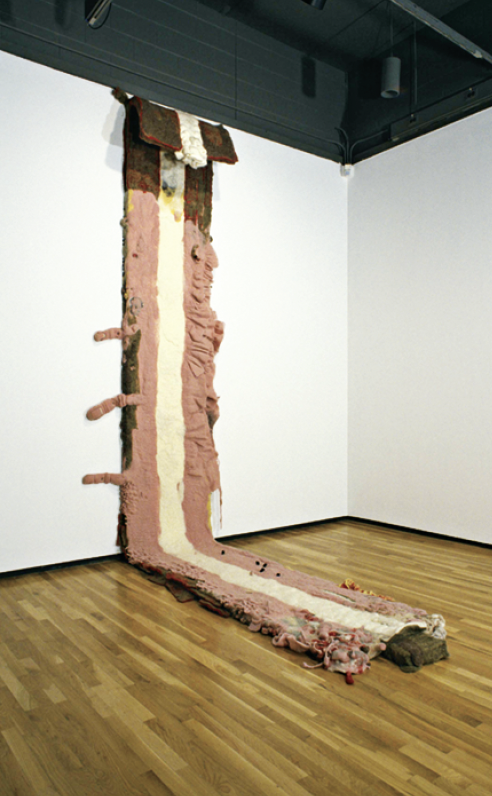
Luanne Martineau, Parasite Buttress, 2005, punch felt and bed foam, 21’ x 3’ x 4”. Photo: Tara Nicholson. Courtesy The Banff Centre.
The exhibition is at its tightest and most rigorous up to this point. Then it moves outward from the domestic/surburban focus with Japanese architect Kyohei Sakaguchi’s A Zero Yen House with Solar System (replica), 2006, a model based on the ingenious portable dwellings constructed by Tokyo’s homeless, and the video and digital animation, Philosophy of Time Travel, 2007, in which Brancusi’s Endless Column is hurled through an exterior wall into the Harlem Museum, made by the American collective of Edgar Arceneaux, Vincent Galen Johnson, Olga Koumoundouros and Matthew Sloly. To open the show to urban and institutional issues, these two interesting works are not really enough, making “Informal Architectures” feel somewhat incomplete, perhaps because the major part of the exhibition is so strong, it leaves you wanting more.
Well, more is coming. “Informal Architectures” is bigger than an exhibition. It is a four-year academic research project that Kiendl worked on in England, where he was a visiting research fellow at Middlesex University, and in Canada. Other parts of the project have included the commissioning of new works for the show; a symposium at Tate Modern in London, with panel presentations by Luanne Martineau, David Hoffos and Eleanor Bond; and lectures by Jimmie Durham and Dan Graham (available for viewing as a podcast at Tate Online, www.tate.org.uk).
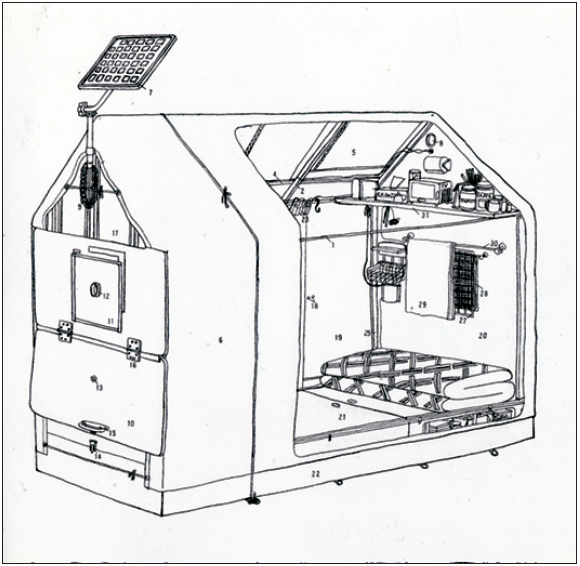
Kyohei Sakaguchi, Zero Yen House’s drawing, 2001, tracing paper, 59 x 84 cm. Courtesy The Banff Centre.
A publication that brings all the aspects of this important project together will be launched in North America in the spring, and the show will be remounted at Plug In ICA from May 2 to June 28, 2008. A new configuration of the exhibition undoubtedly will provide fresh juxtapositions and different angles on the theme, which will nonetheless remain the same. “The way I have approached the exhibition from the beginning is looking at curating as a creative practice. I wanted to tell a story and try to negotiate the line where each piece is adding a paragraph. As you walk through, it unfolds. The selection of the works had to make sense in that unfolding.” ■
“Informal Architectures,” a group exhibition curated by Anthony Kiendl, was exhibited at the Walter Phillips Gallery at The Banff Centre from June 22 to September 23, 2007. The exhibition will travel to Plug In ICA, Winnipeg, from May 2 to June 28, 2008.
Nancy Tousley is an award-winning art critic and journalist.

